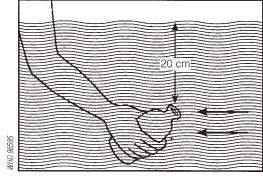12.6.2 Procedure for sampling from a watercourse or reservoir
For towns and cities it is common for the water source to be a river or a reservoir, due to the large quantity of water needed each day by the population. Samples from the water source will be analysed using the following parameters:
- temperature, which can affect dissolved oxygen content and treatment
- dissolved oxygen, to determine if the water has oxygen and thus is devoid of undesirable products from anaerobic processes
- colour and odour, for acceptability to consumers
- turbidity, to determine if pre-treatment of the water is necessary
- suspended solids, to ascertain the level of treatment needed
- pH, to see if adjustment is needed
- organic compounds, metals and nitrate to determine if unacceptable levels of pollutants are present
- coliforms and pathogens, to determine the level of treatment required
- phytoplankton, to determine if removal is needed to eliminate odour and taste problems.
Phytoplankton are microscopic plants and other photosynthetic organisms that live in water.
The steps for water sampling are as follows:
- Open the sterilised bottle as described above.
- Fill the bottle by holding it by the lower part and submerging it to a depth of about 20 cm, with the mouth facing slightly upwards. If there is a current, the mouth of the bottle should face towards it (Figure 12.6).
- The bottle should then be capped.

12.6.1 Procedure for sampling from a tap or pump outlet
